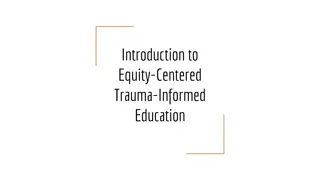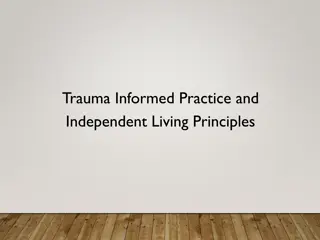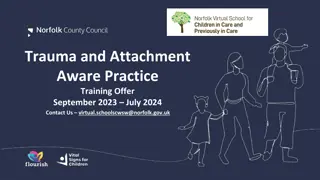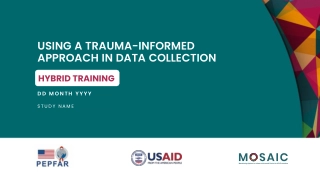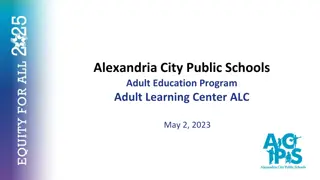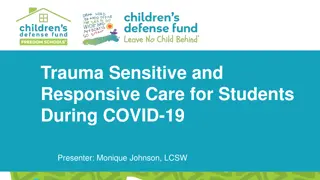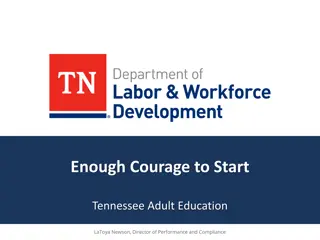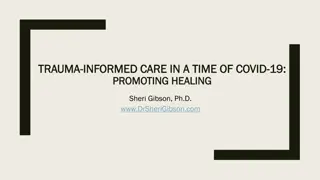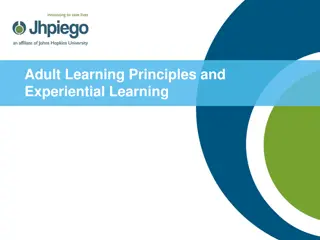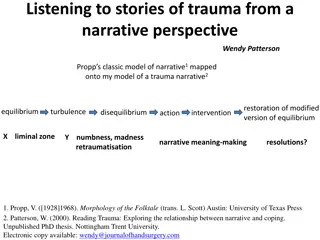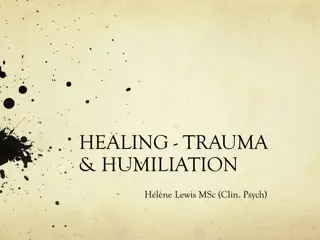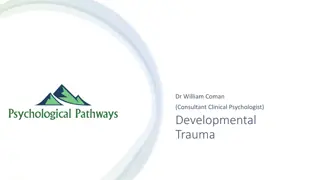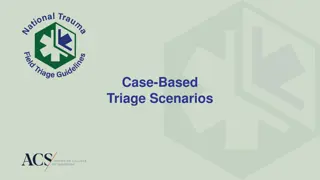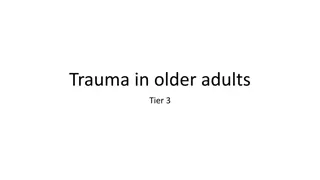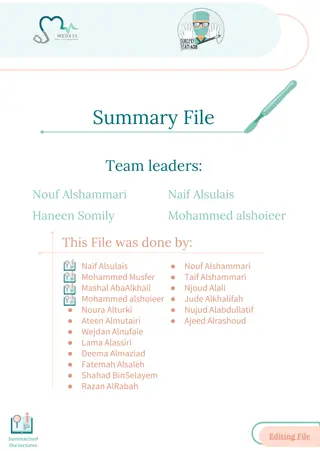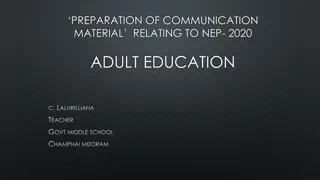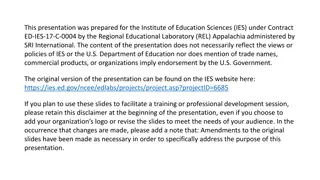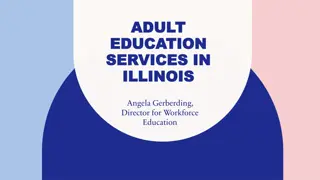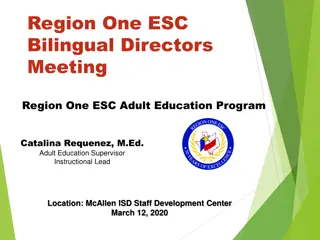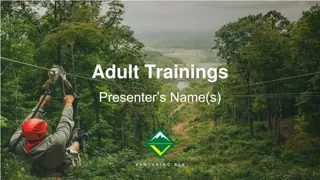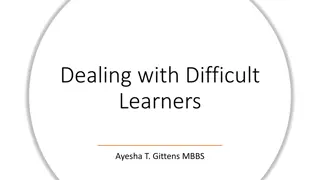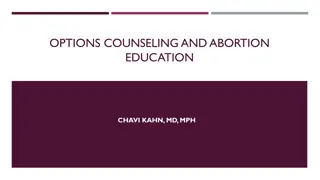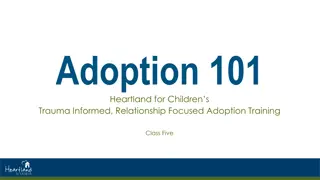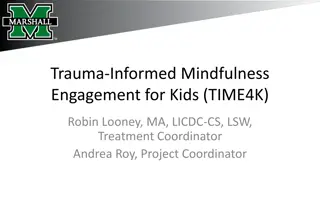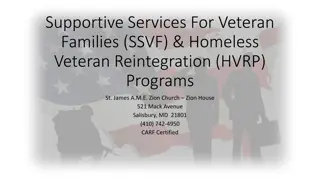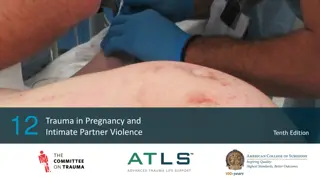Trauma-Informed Practices in Adult Education: Creating a Supportive Learning Environment
Explore how trauma-informed practices can enhance adult education by addressing trauma, promoting brain-based learning, cultural responsiveness, and more. Learn strategies to support students effectively and foster a welcoming atmosphere for diverse learners.
- Trauma-informed
- Adult education
- Learning environment
- Brain-based learning
- Culturally responsive teaching
Download Presentation

Please find below an Image/Link to download the presentation.
The content on the website is provided AS IS for your information and personal use only. It may not be sold, licensed, or shared on other websites without obtaining consent from the author. Download presentation by click this link. If you encounter any issues during the download, it is possible that the publisher has removed the file from their server.
E N D
Presentation Transcript
Trauma Trauma- -informed Practices informed Practices in Adult Education in Adult Education Katie Donoviel English Skills Learning Center
Overview Overview WARM UP WARM UP LEARN LEARN Theory 2 NOTE: I am an educator I am an educator sharing what I have learned about trauma and how educators can use trauma-informed practices to create more welcoming environment for EVERYONE. Brain-based learning Affective Filter Culturally Responsive Teaching Trauma Basics Responding to Someone in Crisis APPLY APPLY Areas of Consideration Registering New Students Designing Curriculum and Materials Approaching Instruction Maintaining Student Privacy REVIEW REVIEW
3 WARM UP WARM UP
4 Word Association Word Association Great Teaching
5 LEARN LEARN
6 Brain Brain- -based Learning Theory based Learning Theory A healthy body promotes a healthy mind. Bring movement into the classroom. Emotions are key to memory, meaning, and attention Interaction with others benefits brain development Teaching each other boosts memory Memory improves through practice Long lectures are ineffective Content has to be meaningful Information has to be moved from short- to long-term memory Stress impairs learning Swan, M. (2019). What is brain-based learning? Retrieved from https://www.classcraft.com/blog/what-is-brain-based-learning/
7 Affective Filter Hypothesis Affective Filter Hypothesis When filter is high, students Feel stressed and anxious Lack self-confidence Have reluctance to participate When filter is low, students Become risk-takers in the classroom Feel safe making mistakes without judgement Feel empowered to interact with their peers
8 Culturally Responsive Teaching Culturally Responsive Teaching Multicultural Education Multicultural Education Social Justice Education Social Justice Education Culturally Responsive Teaching Culturally Responsive Teaching Focuses on celebrating diversity Focuses on exposing the social political context that student experience Focuses on improving learning capacity Focuses on improving learning capacity of diverse students who have been of diverse students who have been marginalized educationally. marginalized educationally. Centers around diversity and inclusion efforts Centers around anti-racists efforts Centers around efforts to accelerate Centers around efforts to accelerate learning learning Concerns itself with exposing privileged students to multiple prescriptives and other cultures. Fro students of color, focus is on seeing themselves reflected in the curriculum. Concerns itself with creating a lens to recognize and interrupt inequitable patterns and practices in society. Concerns itself with building cognitive Concerns itself with building cognitive capacity and academic mindset by capacity and academic mindset by pushing back on dominant narratives pushing back on dominant narratives about people of color. about people of color. Goal: Social Harmony Goal: Critical Consciousness Goal: Independent Learning for Agency Goal: Independent Learning for Agency
10 Jigsaw Jigsaw Expert Group Expert Group Read your handout independently Discuss the handout with your group Be prepared to share a summary with other groups Jigsaw Group Jigsaw Group Form new groups, containing one member of each expert group Share the information from your expert group Whole Group Whole Group Discuss together
11 What is Trauma? The 3 Es What is Trauma? The 3 Es Trauma is the short and long-term adverse effects individual s functioning and mental, physical, social, emotional, and/or spiritual well-being, resulting from an event event (or series of events or circumstances) an individual has experienced experienced as physically and/or emotionally harmful or life threatening. effects on an Substance Abuse and Mental Health Services Association (SAMHSA)
12 What Does a Trauma Response Look Like? The 4 Fs What Does a Trauma Response Look Like? The 4 Fs The ways in which people respond when overwhelmed, stressed, or in relation to traumatic incidents. FIGHT FIGHT - defensive, anger, explosive behavior, controlling FLIGHT FLIGHT - anxiety, perfectionism, panic, removing oneself FREEZE FREEZE - isolation, difficulty making decisions, zoning out FAWN FAWN - people pleasing, lack of identity, no boundaries
13 What Does it Mean to be Trauma Aware? The 4 Rs What Does it Mean to be Trauma Aware? The 4 Rs Trauma-awareness is guided by four assumptions, known as the Four Rs Being trauma-aware means having a realization is and how it can affect people and groups. Recognizing signs of trauma and having a system which can respond trauma, and resisting re resisting re- -traumatization. traumatization. realization of what trauma Recognizing the respond to
14 What Does it Mean to be Trauma What Does it Mean to be Trauma- -informed? The 6 informed? The 6 1. Safety 2. Trustworthiness and Transparency 3. Peer Support and Mutual Self-help 4. Collaboration and Mutuality 5. Empowerment , Voice, and Choice 6. Cultural, Historical, and Gender Issues
15 Responding to Someone in Crisis Responding to Someone in Crisis Act calm, even if you re not **Ask them if they want a glass of water Actively listen and respect privacy Don t try to problem solve for them (with --maybe) Remember your own boundaries Refer to professional services, as appropriate Follow up with ways to cope with vicarious trauma
16 APPLY APPLY
17 Areas of Consideration Areas of Consideration 1. Registering New Students 2. Designing Curriculum and Materials 3. Approaching Instruction 4. Maintaining Student Privacy
18 Registration Registration Position students so they have a full view of the entry Sit at a 90-degree angle from students, not across a table Dress a bit more casual if doing intake/registration Warn students that you ll be asking them personal questions Explain why you need the information Explain what you are doing if you have to leave the room or stand up suddenly Have water and tissues at the ready Be ready to listen, not just collect data points Use translation/interpretation whenever possible
19 Curriculum and Materials Curriculum and Materials Predicting ALL potentially triggering topics is impossible, but you can be smart about it! Rather than avoiding topics, provide a warning when you think topics might be triggering Consider the images you use (e.g., health literacy) Give students agency over topics, when possible Use relevant, age- and level-appropriate materials with differentiation Scaffold to build independent learners
20 Instruction Instruction Be the warm demander Focus on building rapport between teachers and students as well as between students Differentiate approaches and scaffolding Establish classroom routines to provide predictability and consistency Provide a preview of the day and outline goals / objectives Consider when and how to provide corrective feedback Remember to provide genuine positive feedback Allow for translanguaging, as appropriate
21 Privacy Privacy Don t pry for information. You don t have a right to anyone s story. Keep information confidential, as possible Consider ways to cope with vicarious trauma without revealing students identities Be mindful of what you discuss in the presence of others (coworkers, family, friends, and other students)
22 REVIEW REVIEW
23 3, 2, 1 Exit Ticket 3, 2, 1 Exit Ticket 3 Concepts you learned or reviewed today 2 Concepts you want to learn more about 1 Concept you can apply immediately
24 Thank you! Questions? Thank you! Questions? Katie Donoviel k.donoviel@eslcenter.org








